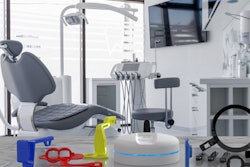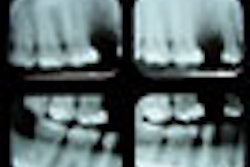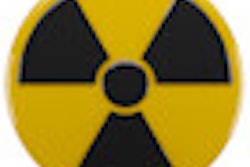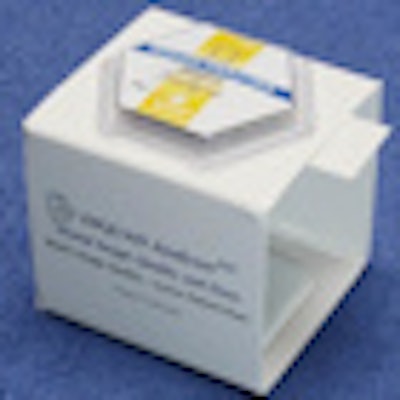
A novel device for evaluating the image quality and patient dose of intraoral x-ray systems is gaining favor among radiation protection agencies and dental offices.
The DIQUAD (Dental Image Quality and Dose) Analyzer was developed by Joel Gray, PhD, a medical physicist with an extensive background in medical imaging and personal dosimetry devices. Gray developed the DIQUAD concept while he was at Landauer and was granted worldwide rights to it when he left Landauer to found DIQUAD.
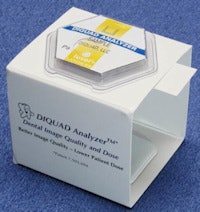 The DIQUAD Analyzer is a flat cardboard device that unfolds into a box holding a Landauer Luxel+ dosimeter, test objects, and a packet of dental film. All images courtesy of Joel Gray, PhD, DIQUAD.
The DIQUAD Analyzer is a flat cardboard device that unfolds into a box holding a Landauer Luxel+ dosimeter, test objects, and a packet of dental film. All images courtesy of Joel Gray, PhD, DIQUAD.
For the last few years, he has been marketing the patented Analyzer device and process as a cost-effective, mail-order service for state radiation protection groups.
"DIQUAD provides a complete service for dental offices, evaluating dental x-ray image quality and radiation dose," Gray said. "At this point, we deal primarily with state radiation protection agencies, which really appreciate the necessity of having a good image. We are providing them information they couldn't get otherwise, and we do it more cost-effectively because we do it by mail."
DIQUAD is currently working with radiation protection agencies in half a dozen U.S. states, including California and Pennsylvania, and expects to have 10 to 15 more states under contract within a year, Gray added.
"Almost every state in the U.S. requires a periodic assessment of all radiographic equipment in a dental, medical, or hospital setting," he said. "In California, it is every five years. Our approach reduces the burden on the state to have to send out inspectors to these offices to evaluate and test this equipment."
How it works
The state agencies provide DIQUAD with a list of facility names and addresses that are nearing their inspection date. DIQUAD then mails each facility a kit that includes an Analyzer, user's guide, and data form. The Analyzer consists of a flat cardboard device that unfolds into a box holding a Landauer Luxel+ dosimeter, test objects, and a packet containing both D-speed and E-F-speed dental film. The Analyzer can also be used with digital dental imaging systems, according to Gray.
In the dental office, the technologist places the Analyzer on a solid surface, positions the x-ray tube directly on the Analyzer, makes an exposure, and processes the two films. The Analyzer, control dosimeter, processed films or digital images, and data form are then placed into a postage-paid envelope and returned to DIQUAD.
Selected metal filters and a mesh target provide the test patterns for image quality analysis. The Luxel+ dosimeter is analyzed by Landauer, which provides the raw data that DIQUAD uses to derive dose and beam quality information. Restults include:
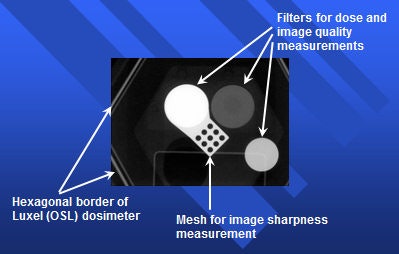 A sample Analyzer image, showing the filters, mesh, and dosimeter border.
A sample Analyzer image, showing the filters, mesh, and dosimeter border.
- Image sharpness
- Film or digital image contrast
- Film density or digital image gray level
- Film speed
- Film base + fog level or digital image background level
- Film processor or digital image quality
- Residual sodium thiosulfate (hypo or fixer)
- Patient dose
- Half-value layer
After digitizing and analyzing the films or digital images, DIQUAD combines the image quality, residual sodium thiosulfate measurement, and dosimetry information into a summary report that is sent to the state agency. The report highlights those measurements that do not pass the criteria and provides guidance on how to correct the problem. The criteria are based on a large number of DIQUAD measurements and typically represent the 75th percentile of those measurements, according to Gray.
"Radiation inspectors test for the amount of radiation in a facility and whether people are standing behind a wall when making an exposure," he said. "We can't do that, but we can provide more information about the image quality. And image quality and dose go hand in hand."
In a presentation July 31 at the American Association of Physicists in Medicine meeting in Vancouver, Canada, Gray outlined how the DIQUAD Analyzer works and the advantages it offers to dental offices.
"Several studies relative to the accuracy and precision of the measurements indicate that the dose and half-value layer can be determined to about 10%," he noted in his presentation. "Our experience with measurements of over 4,500 intraoral x-ray units indicates issues that must be addressed through education of dental facility staff, including the fact that 25% of the facilities exceed reasonable patient dose levels, 80% still use D-speed film, and photographic processing is a major issue. Dentists should know the dose they are giving their patients and verify that the image quality is good."
While the DIQUAD Analyzer is not currently designed to evaluate panoramic or cephalometric equipment, the company is working in this direction, Gray added.




